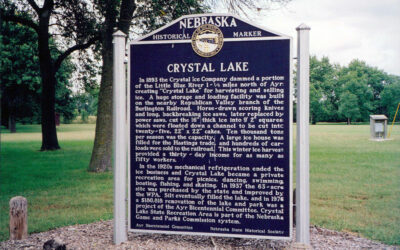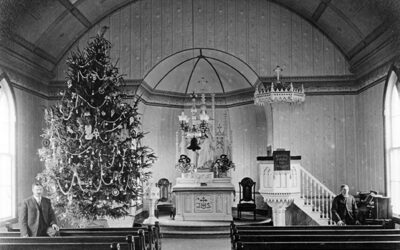By David L. Bristow, Editor
When we think about landmark buildings, gas stations probably aren’t the first places that come to mind. But they’ve been part of life for more than a century and tell a story of social and technological change. These photos illustrate how automobile culture developed in Nebraska.
In the early days, motorists bought cans of gasoline from blacksmith shops and pharmacies. An Indiana inventor named Sylvanus Bowser invented a kerosene pump in 1885. Years later he adapted it as a gasoline pump, adding a hose attachment in 1905 so motorists could pump fuel directly into their automobile’s tank. These curbside pumps became known as “filling stations.” Usually you found them at blacksmith shops or general stores.
The nation’s first drive-in filling station opened in Pittsburgh, Pennsylvania in 1913. As the idea spread, station owners began to expand the range of products and services they offered. They promoted themselves with creative signage and distinctive buildings. Along Nebraska’s highways, some stations offered “auto camps” or became colorful tourist traps offering attractions and souvenirs.
Most of the colorful gas stations of the early- to mid-twentieth century are gone. Some remain in ruins, some have been documented by various photographers, and a few remain as functioning businesses luring travelers with nostalgia for an earlier era.

Having a women’s restroom was an amenity worth bragging about. Arnold, Nebraska, circa 1930. Archive.org

As automobile tourism grew, some stations provided lodging as well as a fuel. Auto camps were a predecessor of motels (short for “motor hotel”). This one in Ogallala, shown circa 1930, boasted heated cabins and “free shower baths.” RG2105-3-71

This old Wadhams station in Pilger was dilapidated by the time this photo was taken in the mid-20th century, but the building was a landmark in its day. Between 1917 and 1930, Wadhams Oil and Grease Company of Milwaukee built more than 100 pagoda-roofed filling stations across the Midwest. The company had no Japanese ties; it was simply a marketing strategy at a time when Japanese culture was relatively popular in the US. RG2587-1-9

The Covered Wagon Gift Shop was already past its prime when photographer John Margolies took this picture in 1980. Located west of Kearney, the giant team and wagon lured Highway 30 tourists with a chance to fuel up and purchase souvenirs. Library of Congress

This 1960s postcard promotes Rasmus Oil Co. in West Point. Proudly displaying their fleet of service trucks, the station seems most interested in promoting its range of services for the local community. RG3334-3-29

This old clockface gas pump was still standing in Wauneta when photographer John Margolies noticed it in 1980. Library of Congress
This article first appeared in the December 2019 issue of NEBRASKAland Magazine.
Learn more about John Margolies’ “Roadside America” photos at the Library of Congress.
(11/30/2020)



